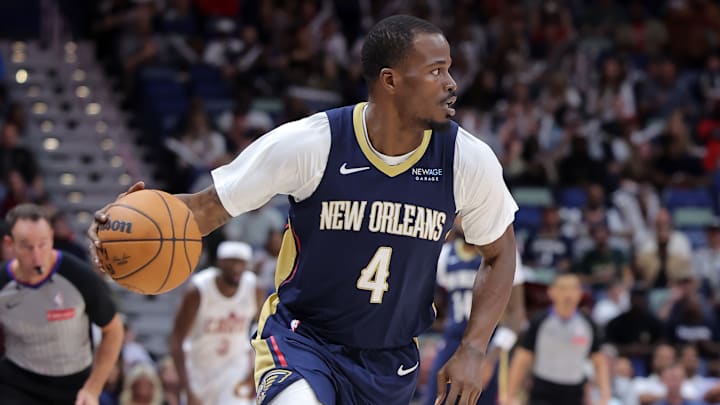It's not often that a team finds a solid rotational piece in the buyout market, but the Cleveland Cavaliers might have done just that.
Following a buy-in trade at the deadline for De'Andre Hunter, the Cavaliers dropped below the 14-player minimum for rosters in the NBA. This requirement does not include two-way players, meaning Cleveland would need to add another player within two weeks of falling below that threshold. As the clock winded down to make a decision, the Cavs are reportedly finalizing a deal to sign veteran wing Javonte Green of the New Orleans Pelicans following a contract buyout.
In his sixth season, Green has averaged 5.8 points and 3.6 rebounds with the Pelicans, serving in a low-usage bench role. He joined New Orleans after becoming a fan favorite presence with the Chicago Bulls for three-and-a-half seasons. While Green has never been an All-Star talent, the 6'5" wing is a versatile player with plenty to offer any competitive franchise.
With the Cavaliers, Green will not see much, if any, action in the postseason. His time will mostly be spent helping the Cavs' wing rotation survive injury bugs, especially with head coach Kenny Atkinson's tendency to take a patient approach before bringing players back to the court.
While the latest Cavalier will not compete for a starting role or change Cleveland's trajectory in the playoffs, this deal should be more than a half-season rental with a long-term objective in mind. At 31 years old, Green still has years of good service to offer and could provide crucial value for the Cavaliers' near future.
Clelveand will love Green's positional versatility
Like most Cavaliers wings, Green is relatively undersized but plays bigger than his frame would suggest. The bulk of his minutes are spent at the small forward or shooting guard positions, but Green has easily filled time at the power forward spot in small-ball lineups.
Defensively, Green's solid base and upper body strength is an underrated tool. Cleveland's other small wings, Isaac Okoro and Max Strus, use these same tools to defend bigger opponents and maintain a solid defensive presence. Okoro has especially developed a reputation for this, garnering praise as a defender with endless versatility. Green is not on the level of Okoro or Strus, but as an added wing, he is more than capable of making an impact.
On the offensive end, Green is more athletic than the typical veteran, especially those who are bought out mid-season. He can play on the perimeter, keeping pace with his teammates while also making smart cuts and scoring in the paint. This year, Green is averaging 1.59 points per possession on cuts, ranking in the 91st percentile per NBA.com, making a quality off-ball threat in Atkinson's system.
Before this season, Green has consistently ranked in the top 10-20 percent of players at his position in points per shot attempted, per Cleaning the Glass. While he is never the top scorer or go-to guy, he consistently provides positive impact on both ends of the court, ranking in the top third for on/off point differential (subscription required).
This versatility is a skill the Cavaliers will make the most of, regardless of the size of his role in his first half-season with the squad. In the future, though, Cleveland should prioritize retaining Green to integrate him into this system as protecting themselves from future changes.
Green gives the Cavaliers trade insurance
The Cavaliers are the top team in the Eastern Conference and began their season on a historic run. Making a deadline trade seemed entirely unnecessary by looking at the basic numbers. Still, Cleveland refused complacency and chased a win-now and win-tomorrow deal with Hunter. They were able to accomplish this because of their vast depth, making them able to consolidate two players like Caris LeVert and Georges Niang into the ideal 3-and-D wing they needed.
Regardless of the result of this season, whether there is as second Finals banner in the arena or not, the Cavaliers are entering unknown territory. With a new Collective Bargaining Agreement adding highly-restrictive tax aprons, the Cavs' pricey core four will push them over the second apron and prevent them from any exceptions in free agency.
Going forward, the Cavaliers cannot take any extra money back in a trade and cannot combine salaries to absorb a larger salary. Until they dip below the second apron again, Cleveland's trade moves will be few and far between. Re-signing Green to another veteran minimum contract (the only deal he is likely to get anywhere else) could allow the Cavaliers to have some more freedom in these roster maneuvers.
As time goes on, the future of Cleveland's mid-size contract players is in question. Notably, Strus and Okoro are similar players to Green who are on tradeable deals. Okoro signed a new contract worth roughly $10 million per season last summer, and Strus is owed $16.5 million on his deal. Green provides that necessary depth to serve as trade insurance if the Cavaliers need to move on from one of these wings for any reason.
Green is by no means better or more valuable than these two current Cavaliers. But, Cleveland is going to be forced to make difficult decisions in the not-so-far-off future. The NBA, in an attempt to prevent unfair super teams, is now punishing homegrown franchises from retaining their stars and building a competent supporting cast around them. Keeping Green in town alleviates some of the most stressful elements of this CBA for the Cavs.
Buyout players do not dramatically shift the season for any franchise. Javonte Green is a good complementary player with a proven track record that could help the Cleveland Cavaliers. Unlike many other players in the buyout market, though, Green can give the Cavs a lot more than a body on the bench going forward.
